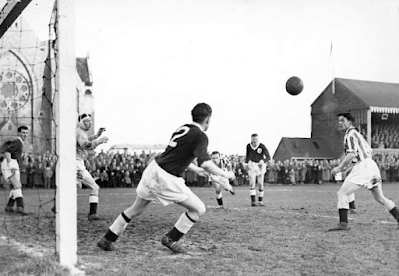The Ups and Downs of Scotland's Pyramid | @AlexHTheMAX
A new Scottish League club could emerge in the summer as the 2021/2 season reaches its closing stages north of the border.
@AlexHTheMAX reveals the historic new name that could be on your Acca next season while reminding us a long running Scottish League side will be fighting for its historical place in the SPFL in May 2022 also.
Bonnyrigg Rose Athletic have already claimed the play off spot from the Lowland League, whilst four genuine contenders continue to jostle for the Highland League title in the other 5th tier division of the Scottish pyramid system.
One club from Fraserburgh, Brora Rangers, Buckie Thistle and Brechin City will represent the Highland League in this season's end of campaign play offs.
Fraserburgh would give Scotland's Buchan coast a second league team if successful, following near neighbours Peterhead (elected to the SPFL in the late 1990s), into the Scottish League.
 |
| Fraserburgh (stripes) beat Dundee in the 1959 Scottish Cup |
Buckie Thistle have claimed wins over Scottish League sides in the Scottish Cup for 50 years, so it would be no surprise if the northern Jags finally claimed a League 2 place. Meanwhile Brora Rangers, who missed out to Montrose in the first Scottish pyramid play-off final in 2015, are showing hunger for SPFL inclusion once again.
Brechin City have a slight hope of regaining the League 2 place they lost to Kelty Hearts last season, but the traditional Highland teams above City currently are better placed to step up.
With Celtic's and Rangers' B teams unable to claim promotion from the Lowland League it's the case that even if current leaders, Bonnyrigg, finish second in that league, they'll still be in pole position from central Scotland and borders non league to make the step up to Scottish League 2.
Awaiting the winners of Highland v Lowland League champions over two legs will be "Team 42" also better known as the club that finishes last in SPFL League 2.
A groundhopper favourite in the shape of Cowdenbeath have battled the odds all season to lose Team 42 status but time is running out now for the Fife side who have been anything from 4 to 10 points adrift since the turn of the year.
Above the Fifers, Albion Rovers (formed 1882), Elgin City (1893) and Stirling Albion (1945) are not clear of the trap door yet in League 2. However, right now Cowden (a Scottish League side since 1905) would appear favourites to be squaring up to Bonnyrigg or an ambitious Highland eleven home and away at the end of the current campaign.
Bonnyrigg had none other than Sean Connery playing for them briefly in the 1950s and the future 007 must have been good because he was later offered terms at Manchester United by Matt Busby before Sean decided there was a longevity in acting that didn't exist in football.
 |
| The Lowland League representative in the 2022 play-off is decided |
 |
| Bonnyrigg players celebrate the club's Bond connection in 2017 |
The Pyramid in Scotland was a long time coming but it's proved to be a success since its formation in 2014.
Kelty Hearts are close to the League 2 title in their first season as an SPFL club. 2016 play-off winners Edinburgh City are well established as a top club now in the same division, while 2019 pyramid play-off winners Cove Rangers (based in Aberdeen at Balmoral Stadium), are odds on for Scottish Championship football in August.
Football purists in far flung corners of the UK would maybe wish Cowdenbeath's survival, such is their legend amongst followers of lower league football, but the other perennial strugglers in the relegation mix, Coatbridge based Albion Rovers, will also have their supporters outside West Central Scotland.
 |
| Cowdenbeath 4-1 Fraserburgh - Scottish Cup 1974 (www.bluebrazil.co.uk) |
All will be revealed soon enough, so get that map of Scotland out if you're looking to venture across the border and into the ups and downs of the 2022 Pyramid play off.
All the clubs mentioned would welcome your visit.
Scottish Pyramid Play-off Final History
(Any League 2 club relegated is designated a place in Lowland or Highland League based on geography)
List of finals:
2015 - Montrose (Team 42, bottom of League 2) beat Brora Rangers (Highland League Champions)
2016 - Edinburgh City (Lowland League Champions) beat East Stirlingshire (Team 42)
(Falkirk based East Stirlingshire into Lowland League.)
2017 - Cowdenbeath (Team 42) beat East Kilbride (Lowland League)
2018 - Cowdenbeath (Team 42) beat Cove Rangers (Highland League)
2019 - Cove Rangers (Highland League) beat Berwick Rangers (Team 42)
(Borders side Berwick Rangers into Lowland League.)
No play off in 2020 due to covid.
2021 - Kelty Hearts (Lowland League) beat Brechin City (Team 42)
(Angus based Brechin into Highland League)
2022 - Should Cowdenbeath, Albion Rovers or Stirling Albion be relegated they'd be placed in Lowland League. An Elgin City relegation would see them in Highland League.
 |
| Cowdenbeath have fallen far since 2014/2015 |
By Alex Horsburgh, written for @TFHB.
(All pictures borrowed and NOT owned in any form by TFHB)




Comments